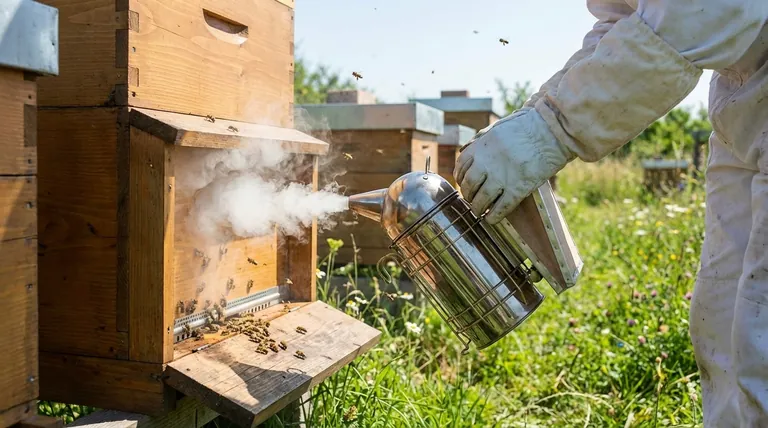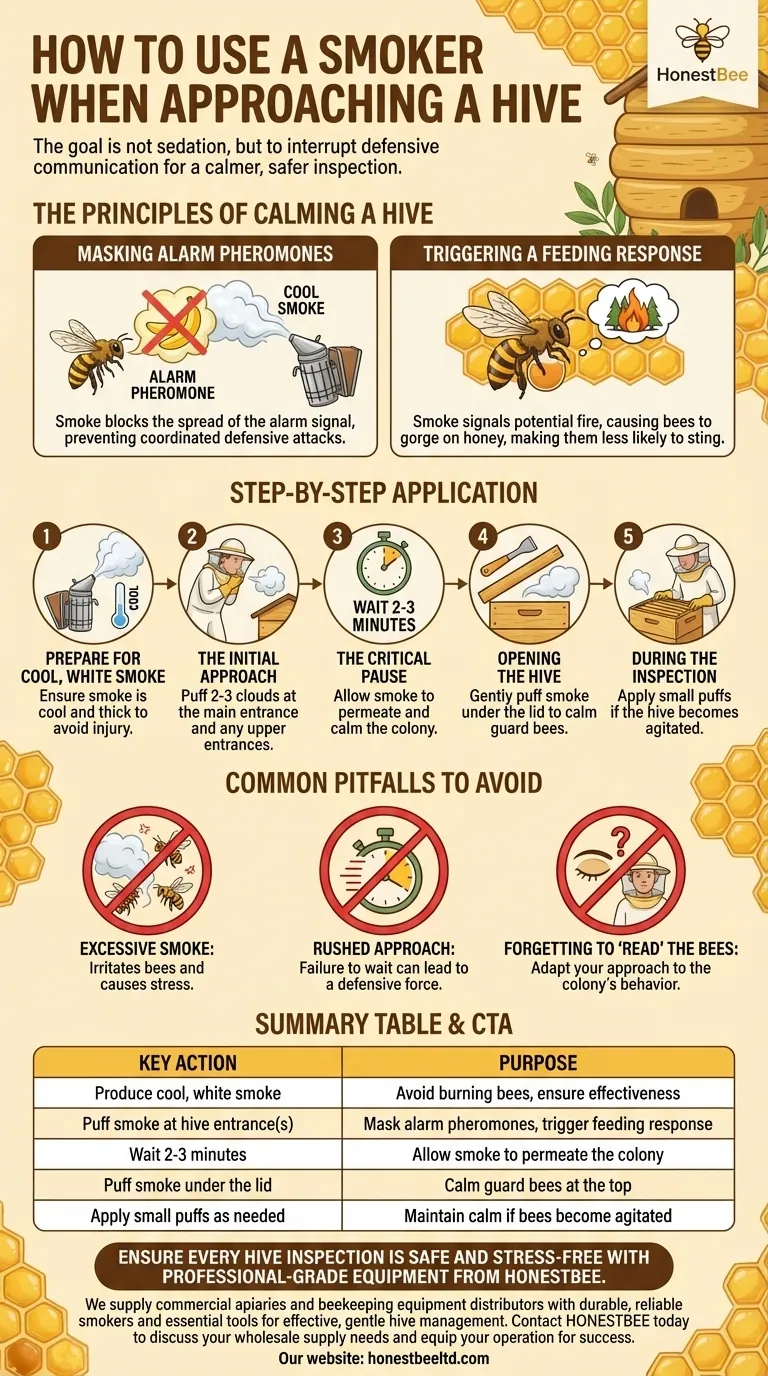To use a smoker when approaching a hive, first apply a few gentle puffs of cool, white smoke at the main entrance and any upper entrances. Wait several minutes for the smoke to permeate the colony before you begin. After you gently crack open the hive lid, puff a small amount of smoke under it to calm the bees at the top of the hive.
The fundamental goal of using a smoker is not to sedate the bees, but to gently interrupt their defensive communication. By using minimal, cool smoke, you mask their alarm signals and encourage a natural feeding response, leading to a calmer and safer hive inspection for both you and the bees.

The Principles of Calming a Hive
To use a smoker effectively, it's crucial to understand what the smoke is actually doing. It works on two primary levels to interrupt the bees' natural defensive instincts.
Masking Alarm Pheromones
When a bee feels threatened, it releases an alarm pheromone, which smells like bananas. This chemical signal instantly alerts other guard bees to a potential danger, putting the entire colony on high alert.
Cool smoke effectively masks this pheromone, preventing the signal from spreading. This short-circuits their defensive communication, making a coordinated attack much less likely.
Triggering a Feeding Response
The presence of smoke also triggers a primal survival instinct in bees. They associate smoke with a forest fire, signaling that they may need to abandon their hive.
In preparation, they begin to gorge themselves on honey to store energy for the potential journey. A bee with a full stomach is physically less able to flex its abdomen to sting and is generally more docile and preoccupied.
The Step-by-Step Application
Proper technique is about timing and moderation. The goal is to be a calming presence, not an overwhelming force.
Prepare for Cool, White Smoke
Before you even approach the hive, ensure your smoker is producing the right kind of smoke. It should be thick, white, and cool to the touch a few inches from the nozzle. Hot smoke can burn and injure your bees.
The Initial Approach
Stand to the side of the hive, not directly in the bees' flight path. Gently puff two to three clouds of smoke toward the main entrance. If you have an upper entrance, give it a puff as well.
The Critical Pause
This is one of the most important and often-skipped steps. After applying smoke to the entrance, wait for at least two to three minutes. This pause gives the smoke time to circulate through the hive and achieve the desired calming effect.
Opening the Hive
Use your hive tool to gently pry open the outer and inner covers. As soon as you have a small gap, puff one or two clouds of smoke across the top of the frames. This pacifies the guard bees that are often waiting just under the cover.
During the Inspection
As you work through the hive, pay attention to the bees' behavior. If you hear the "buzz" of the colony begin to rise in pitch or see bees becoming agitated, apply a small puff of smoke across the top of the frames you are working on.
Common Pitfalls to Avoid
Using a smoker is a skill that requires finesse. Avoiding common mistakes is critical for maintaining a healthy, low-stress relationship with your bees.
The Risk of Excessive Smoke
More is not better. Using too much smoke can be counterproductive and harmful. It can irritate the bees, cause them undue stress, and potentially even taint the flavor of your honey.
The Danger of a Rushed Approach
Failing to wait after puffing the entrance is a classic beginner mistake. Opening the hive too soon means the smoke hasn't had time to work, and you will be met with a fully-alert defensive force.
Forgetting to "Read" the Bees
A smoker is a tool, not a command. Always observe your bees' reaction. A calm hive on a sunny day may require very little smoke, while a more defensive colony on an overcast day might need more consistent, gentle application.
Making the Right Choice for Your Hive
Your approach should adapt to the temperament of your bees and the conditions of the day.
- If your primary focus is a routine inspection on a calm hive: Use minimal smoke at the entrance and under the lid, and you may not need any more.
- If your primary focus is managing a known "hot" or defensive hive: Be prepared to apply small, targeted puffs of smoke as you work through the boxes to keep the alarm pheromones suppressed.
Ultimately, a smoker is your primary tool for communicating calm and safety to your colony.
Summary Table:
| Step | Key Action | Purpose |
|---|---|---|
| 1. Preparation | Produce cool, white smoke | Avoid burning bees, ensure effectiveness |
| 2. Initial Approach | Puff smoke at hive entrance(s) | Mask alarm pheromones, trigger feeding response |
| 3. Critical Pause | Wait 2-3 minutes | Allow smoke to permeate the colony |
| 4. Opening Hive | Puff smoke under the lid | Calm guard bees at the top |
| 5. During Inspection | Apply small puffs as needed | Maintain calm if bees become agitated |
Ensure every hive inspection is safe and stress-free with professional-grade equipment from HONESTBEE.
We supply commercial apiaries and beekeeping equipment distributors with durable, reliable smokers and essential tools designed for effective, gentle hive management. Our wholesale-focused operations mean you get the quality gear you need to protect your bees and your investment.
Contact HONESTBEE today to discuss your wholesale supply needs and equip your operation for success.
Visual Guide

Related Products
- European Stainless Steel Bee Smoker for Honey Bee Hive
- Premium Traditional Copper Bee Smoker with Bellows
- Stainless Steel Honey Bee Smoker Hive and Honeycomb Smoker for Beekeeping
- Electric Bee Smoker European Style Bee Hive Smoker for Beekeeping
- Stainless Steel Bee Hive Smoker Beekeeping Smoker for Wholesale
People Also Ask
- Can you use too much smoke on bees? The Right Way to Use a Bee Smoker for Calm Inspections
- What factors should be considered when choosing a bee smoker? Find the Right Tool for Safe, Effective Hive Management
- What are the steps to operate a bee smoker? Master the Art of Gentle Beehive Management
- What are the benefits of smoking bees? Achieve Safer, Calmer Hive Inspections
- What are the features of a recommended bee smoker? A Guide to Safety, Durability & Performance



















